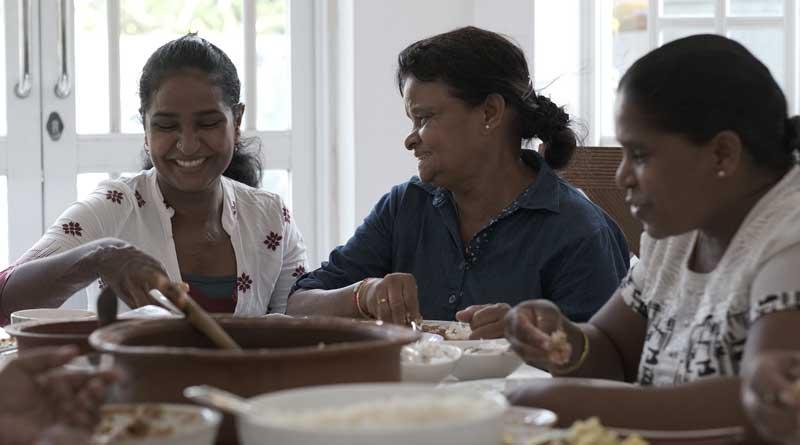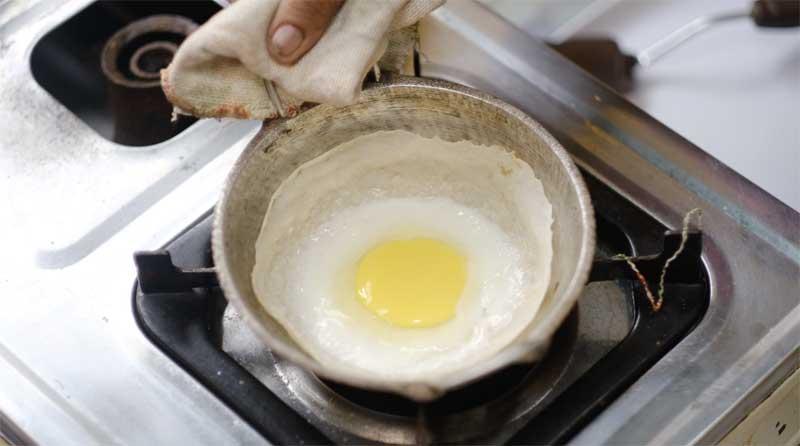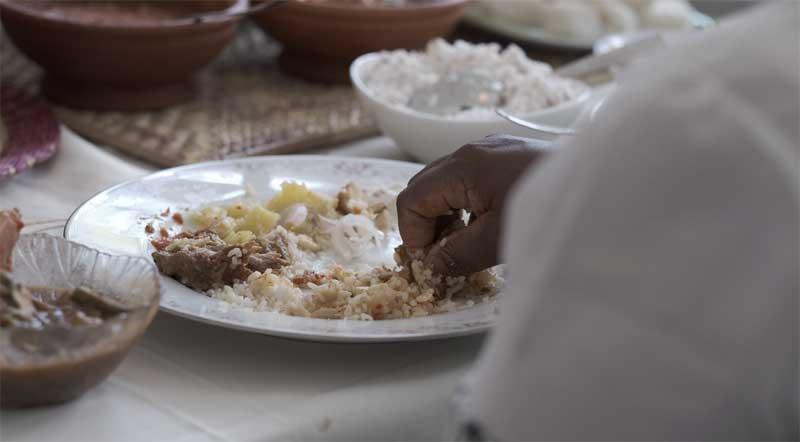Reply To:
Name - Reply Comment
Last Updated : 2024-05-21 02:39:00

A project on women and reparations by the Centre for Equality and Justice
Through marriage and trade from ancient times, Sri Lanka is home to multi-cultural ethnic communities. Much like the emotions, sentiments and compassion we share with each other, the values, respect and traditions which we share among communities, especially portrayed through the Sri Lankan woman as the protagonist, are very much enriched by the ethnic and religious backgrounds we come from. One such extraordinary aspect of culture we connect through is cuisine. Mihiranie et al. in Indigenous and traditional foods of Sri Lanka (2020) explains that, “Buddhism and Hinduism that existed since ancient times with the later introduction of Islam and Christianity influenced the religious aspects of food culture, traditions, and taboos.” Our Sri Lankan-ness is fortified by these linkages. Kiribath, Kidu, Hoppers and Kul are popular among the Sinhalese, Tamil and Muslim communities.
There is rarely a festive occasion in Sri Lanka that does not include Kiri Bath (https://www.youtube.com/watch?v=FKLTOO4ir48) . Seen as a symbol of good luck and prosperity by the Sinhala community, kiri bath is a must have dish at almost all events, from New Year celebrations and weddings, to inaugurations and opening ceremonies. Typically made of rice and milk, as the name suggests it is consumed with a range of accompaniments, which generally include fish curry and either katta sambola or seeni sambola. Kiri bath comes in variations like Mung kiri bath, with an addition of green grams and Imbul kiri bath with jaggery and coconut incorporated.
These and other variants of the regular kiri bath recipe have a strong affinity with an equally prominent and festive dish in the Tamil community, pongal. For the Tamil people, Pongal is the central food item served during ceremonial occasions like Thai Pongal and Tamil New Year. It is also regarded as a symbol of prosperity and good luck keeping it very closely linked to kiri bath. The Moors too have their own version of kiri bath, which is referred to as paal soru. The name is a direct Tamil translation from Sinhala, suggesting that this customary dish was inherited by the Muslims from their Sinhala neighbours and friends.

In a basket of woven coconut leaves is an elaborate and tasty spread of rice, meat and vegetables known as kidu (https://www.youtube.com/watch?v=WTO9gXrDpU8). A specialty among the Moors of Sri Lanka, this is a hot favourite during the holy month of Ramadan as a sumptuous dinner after the day’s fast. The composition of accompaniments varies depending on the location of the community. The Galle kidu is generally made up of ‘thawttel’, which is a thick mixed vegetable and yam curry, beef curry, a mallung made of jackfruit, mango curry and sometimes fried beef. The Colombo kidu, on the other hand, includes kaliya, which is a special preparation of brinjal and ash plantain, dahl curry, potato curry, mango curry and a meat curry (either chicken or beef). A single portion of kidu serves six people, stemming from the age-old Muslim tradition of eating together as a community in circles of six. Kidu is a festive meal that is consumed at special religious and family events.
Although it is a hallmark Moor meal, interestingly kidu is almost identical to the Sinhala gotu bath. Translating into receptacle rice, the various curries that make up gotu bath are more or less a mirror of the Galle kidu: beef curry, thawttel (also a mixed vegetable and yam curry), jak mallung and chutney. The Sinhala gotu bath, as indicated by its name, is also wrapped in a container made of woven coconut leaves. The main difference is that each parcel of gotu bath is meant for just a single person. It is fascinating to see how an indulgent and elaborate single rice parcel in one community is a feast for larger groups in another.

Hoppers – there is nothing quite like it. It is so unique that it is difficult to find an analogy for it. Some have described it as an amalgam of a pancake and biscuit with its soft centre and crispy outer skirt. That may be the closest one could get to describing what a hopper looks and tastes like. Referred to as appa in Sinhala and appam in Tamil, hoppers are a very ancient staple. The Tamil name appam literally means ‘cake of rice flour’ and, given its similarity in sound, the Sinhala word appa is believed to be a derivative of this term. Researchers speculate that the word ‘hopper’ was introduced by the British colonialists as their way of pronouncing the vernacular term. However, there is no evidence to support this claim. Besides, the word ‘hopper’ sounds nothing like the Sinhala or Tamil terminology and so this idea remains simply speculative.
Generally consumed for breakfast, it is multi-functional, being popular at dinner time as well. Made of rice flour, coconut water, coconut milk and either soda or toddy, the standard hopper is usually eaten with fish or meat curry and either lunu miris or seeni sambola. It is common to include an egg hopper in this menu. As the name suggests, the egg hopper is a regular hopper with an egg in its centre.
There are numerous delectable variations on the standard hopper recipe. Pani appa is a sweet version that has sugar or treacle and is popular among the Sinhala folk. Meanwhile the paal appam, another sweet type of hopper, is an Eastern specialty that is made by adding thick coconut milk to the centre. Both these varieties are favourites at tea time. The Muslims of Galle have a rather unusual preparation referred to as France Appa or French hoppers – a baked dish comprising semolina, coconut milk, egg and either beef or chicken. It bears absolutely no resemblance to the regular hopper and its name remains a mystery.

A sour and spicy seafood soup, kul is a hallmark of Jaffna cuisine that has made its way onto the ‘must have’ list of visitors to the Northern part of Sri Lanka. It is a delicacy even among the Tamils in Jaffna, the preparation process being very lengthy, and so it is reserved for festive occasions. In Tamil, the word kul simply means a gruel or porridge. But when the people of Jaffna mention kul, they are referring to a very specific dish. Jaffna kul comprises a combination of different types of seafood, from prawns and crab, to cuttlefish and crayfish, and even other types of small fish. These are boiled together with a tamarind and chilli broth. Other ingredients include vegetables like long beans and young jackfruit, and greens such as dampala and murunga leaves. The soup is thickened using odiyal, which is a flour made of the palmyra tuber. There are two special receptacles that are used to consume kul. There is the pilla that is made of dry palmyra leaves which are twisted to create a hollow for the soup. Alternatively, coconut shells that have been cleaned out and dried are also used. Because these ‘dishes’ are both natural they preserve the flavour of the soup.
Today the Tamils of Jaffna are passionate about this traditional dish and have made a ritual of preparing it. Carrying on the communal heritage, the soup is made in a big cauldron with the help of all members of the family and even the guests. The cooking is the focal point of the party with a lot of banter and laughter. While the recipe may alter slightly from caste to caste, the significance of this dish remains the same.
The Sinhala version of kul is kanda. The most common red rice kanda is made of water, red rice and coconut milk, along with some other condiments. Other variations of this vary from Kola Kanda that include different edible leaves, primarily gotukola and Habala pethi kanda made using rice flakes. The Muslim community too have their version of porridge which they call congee. Cooked in chicken broth, garlic and coconut milk, this congee is a favourite among Muslims for iftar and a hearty morning breakfast for big families. Rice and chicken congee with a coconut milk base, is not only a staple in most Muslim homes in the month of Ramadan, it’s also the perfect comfort food.
Much like the overlap in the history of our food, Sri Lankans also experience a shared pain. These shared cuisines and common culinary practices of Sinhala, Tamil and Muslim communities of the country is an ideal manifestation of the common roots we all share. The evolution and adaptation of cuisines and practises from one community to another shows that all communities share a common ground. As such is the ability to share human emotions. To feel trauma, to relate to afflictions, to be sensitive to the pain of another and the need to heal of these wounds are the same for all three communities.
Unsaid in the plates of food shared are those scars carried as women and as ethnic and religious communities. They are able to share these emotions with each other, across ethnicities and communities. Healing requires listening to the stories of women and what they want as reparations. It is critical to ensure that reparations for women of all three communities are catered specifically towards their needs and circumstances and not a ‘one size fits all’ approach.


Add comment
Comments will be edited (grammar, spelling and slang) and authorized at the discretion of Daily Mirror online. The website also has the right not to publish selected comments.
Reply To:
Name - Reply Comment
The state-run loss-making State Mortgage & Investment Bank (SMIB) has reveale
US authorities are currently reviewing the manifest of every cargo aboard MV
On March 26, a couple arriving from Thailand was arrested with 88 live animal
According to villagers from Naula-Moragolla out of 105 families 80 can afford
20 May 2024 - 0 - 84
20 May 2024
20 May 2024

18 May 2024